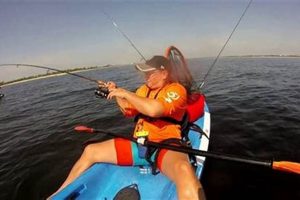A shallow water anchor system designed for kayaks provides quick deployment and retrieval in various bottom conditions, from soft mud to hard sand. This allows anglers to position their vessel securely and silently, maximizing fishing opportunities in specific locations. Imagine being able to stop your drift instantly in a promising fishing spot, maintaining ideal casting position despite wind or current. This type of system offers that precision and control.
The ability to maintain a stationary position offers significant advantages for anglers. It eliminates the need for constant adjustments and reduces noise and disturbance that can spook fish. Historically, anglers relied on traditional anchors, which are often cumbersome and less effective in shallow water. The development of specialized anchoring for kayaks revolutionized the sport, enabling greater precision and stealth. This evolution has improved catch rates and enhanced the overall fishing experience, especially in challenging environments.
This discussion will further explore the various types of shallow water anchor systems available for kayaks, considering factors like ease of use, durability, and compatibility with different kayak models. It will also delve into the specific benefits for various fishing styles and environments, providing a comprehensive understanding of how this equipment enhances angling success.
Tips for Utilizing Shallow Water Anchors
Effective deployment and maintenance of a shallow water anchoring system are crucial for maximizing its benefits and ensuring longevity. The following tips offer guidance for optimal usage and care.
Tip 1: Choose the Right Anchor for the Bottom Composition: Different anchor designs perform better in specific substrates. Research various options to determine the best fit for frequently fished areas.
Tip 2: Deploy the Anchor Vertically: Vertical deployment ensures proper penetration and a secure hold. Deploying at an angle can decrease effectiveness and potentially damage the anchor.
Tip 3: Consider Wind and Current: Factor in wind and current strength when selecting an anchoring location. Positioning the kayak slightly upwind or upcurrent provides optimal stability.
Tip 4: Regularly Inspect Anchor Components: Check for signs of wear and tear, including fraying ropes, bent spikes, or loose connections. Regular maintenance prevents malfunctions and extends the system’s lifespan.
Tip 5: Rinse with Freshwater After Use: Saltwater can corrode anchor components over time. Rinsing with freshwater after each use helps prevent corrosion and maintain optimal performance.
Tip 6: Stow the Anchor Securely: Proper stowage prevents damage to the kayak and ensures the system is readily accessible for deployment. Utilize provided straps or mounts to secure the anchor during transport.
Tip 7: Practice Deployment and Retrieval: Familiarize oneself with the system’s operation before heading out on the water. Practicing deployment and retrieval in a controlled environment ensures smooth and efficient operation when needed.
Adhering to these guidelines ensures optimal performance and longevity of the anchoring system, contributing to a safer and more productive fishing experience.
By understanding and implementing these tips, anglers can confidently utilize shallow water anchors to improve their fishing success and overall experience on the water.
1. Shallow Water Anchoring
Shallow water anchoring is fundamental to the functionality of a fishing kayak power pole. It provides the crucial ability to secure the kayak in a fixed position, differentiating it from drifting or traditional anchoring methods. This capability is paramount for optimizing fishing techniques and overall success in shallow water environments.
- Deployment Mechanisms
Power pole systems employ specialized deployment mechanisms, often utilizing a spike or hydraulic pole, for swift and silent anchoring. These mechanisms differ significantly from traditional anchors and offer distinct advantages in shallow water, minimizing disturbance and maximizing efficiency. For example, a spike can be deployed silently in mere seconds, whereas a traditional anchor requires more time and effort, potentially spooking fish.
- Substrate Compatibility
Effective anchoring requires consideration of the bottom substrate. Power poles are designed to penetrate various bottom types, from soft mud to hard sand or even rocky terrain. This adaptability ensures a secure hold in diverse fishing environments. Specific anchoring systems are often engineered for optimal performance in particular substrates, ensuring maximum effectiveness in various locations. For instance, a wider spike might be preferred for muddy bottoms, while a sharper point is better suited for harder substrates.
- Stability Enhancement
Anchoring significantly enhances kayak stability, particularly in challenging conditions such as wind or current. This stability is essential for precise casting and lure presentation, ultimately improving angling effectiveness. Without a secure anchoring system, maintaining position and accurately presenting bait becomes difficult, potentially impacting fishing success. Power poles address this challenge, providing a stable platform to maximize fishing opportunities.
- Stealth and Reduced Disturbance
Unlike traditional anchors, power pole systems minimize disturbance to the surrounding environment during deployment and retrieval. This stealth is crucial for approaching fish without spooking them, especially in clear, shallow water. The quiet operation and minimal bottom contact associated with power poles are key advantages in these sensitive environments, allowing anglers to remain undetected and enhance their chances of a successful catch.
These facets of shallow water anchoring collectively demonstrate the significant advantages of the fishing kayak power pole system. By enabling rapid, stable, and stealthy anchoring, these systems enhance angling precision and efficacy in diverse shallow water environments. This precision and stability offered by a power pole translate directly to increased fishing success, allowing anglers to focus on technique and strategy rather than constantly adjusting their position.
2. Rapid deployment
Rapid deployment is a defining characteristic of fishing kayak power pole systems and a key advantage over traditional anchoring methods. The speed at which these systems can be deployed and retrieved directly impacts fishing effectiveness, particularly in dynamic shallow-water environments. Consider a scenario where an angler spots a school of fish moving quickly through a shallow flat. With a power pole, the kayak can be anchored instantly, allowing the angler to capitalize on the fleeting opportunity. Traditional anchoring methods would require significantly more time and effort, likely resulting in a missed opportunity. This rapid deployment capability is crucial for maximizing fishing success in such situations.
The mechanical design of power pole systems facilitates this rapid deployment. Whether utilizing a spike or hydraulic system, the deployment process is streamlined and efficient, typically requiring only a single action from the angler. This ease of use contrasts sharply with the more complex and time-consuming process of deploying and retrieving a traditional anchor. Furthermore, rapid retrieval is equally important, enabling anglers to quickly reposition their kayak as needed. For instance, if the fish move or the angler needs to adjust their position for optimal casting, the power pole can be retracted instantly, allowing for seamless repositioning. This agility is essential for maintaining an advantageous position and maximizing fishing efficiency.
In conclusion, the rapid deployment capability of fishing kayak power pole systems is integral to their effectiveness and a significant advantage over traditional anchoring. This feature empowers anglers to react quickly to changing conditions, capitalize on fleeting opportunities, and ultimately enhance their fishing success. The speed and efficiency of deployment and retrieval contribute directly to a more dynamic and productive fishing experience, particularly in shallow water environments where opportunities can arise and disappear in moments. This advantage underscores the value of power pole systems for anglers seeking to maximize their time on the water.
3. Stealth and stability
Stealth and stability are paramount for successful kayak fishing, and the power pole system plays a crucial role in achieving both. Minimizing disturbance and maintaining a consistent position are essential for approaching fish undetected and presenting bait effectively. A power pole’s ability to anchor quietly and securely provides significant advantages in achieving these objectives, contributing directly to enhanced fishing success, particularly in shallow water environments.
- Reduced Noise and Vibration
Traditional anchoring methods often involve noise and vibration from dragging anchors or scraping against the bottom, potentially spooking fish. Power poles, with their swift and silent deployment, minimize these disturbances, allowing anglers to approach fish discreetly and maintain a stealthy presence. This quiet operation is especially critical in shallow, clear water where fish are easily alerted by noise.
- Maintaining Position in Current and Wind
Current and wind can make maintaining a desired fishing position challenging, requiring constant adjustments that create noise and disrupt the water’s surface. A power pole anchors the kayak firmly, enabling anglers to remain stationary regardless of external forces. This stability is crucial for precise bait presentation and effective hooksets, maximizing the chances of a successful catch. For example, a power pole enables an angler to hold a kayak steady above a submerged structure in a strong current, a situation where traditional anchoring or drifting would prove ineffective.
- Improved Casting Accuracy
Kayak stability directly influences casting accuracy. A stable platform allows for controlled and precise casts, maximizing the chances of placing bait in the optimal location. The power pole’s anchoring capability enhances stability, providing a solid base for accurate casting, even in challenging conditions. This enhanced accuracy is particularly important when targeting specific fish holding areas or presenting lures with precision.
- Enhanced Observation and Reaction Time
Maintaining a stable position allows anglers to focus on observation and react quickly to fish activity. Without the need for constant position adjustments, anglers can dedicate more attention to reading the water, identifying fish, and reacting swiftly to strikes. This enhanced awareness and responsiveness can significantly improve catch rates, particularly in situations requiring quick reactions, such as sight fishing.
The connection between stealth, stability, and the fishing kayak power pole is undeniable. By minimizing disturbance and maximizing positional control, the power pole creates an environment conducive to successful angling. These combined benefits contribute significantly to an angler’s ability to approach fish undetected, maintain an optimal fishing position, and react effectively to opportunities, ultimately leading to a more productive and enjoyable fishing experience.
4. Versatile Positioning
Versatile positioning is a significant advantage offered by fishing kayak power pole systems. Unlike traditional anchors that limit positioning options, power poles allow anglers to quickly and precisely place their kayaks in a variety of locations and orientations, maximizing fishing effectiveness in diverse environments. This adaptability is crucial for targeting different species and adapting to changing conditions throughout the fishing day. Consider a scenario where an angler wants to fish a specific weed bed edge parallel to the wind. A power pole allows the kayak to be anchored securely in this precise position, enabling the angler to present lures effectively along the weed line despite wind pressure. This level of control is unattainable with traditional anchoring or drifting.
The ability to hold a kayak in a fixed position against wind or current opens up a wider range of fishing techniques and locations. Anglers can precisely position themselves for sight fishing in shallow flats, maintain an optimal drift along a river channel, or hold steady in ambush points near structures. For instance, an angler targeting bonefish on a shallow flat can use the power pole to stop instantly upon spotting a fish, eliminating drift and maximizing the opportunity for a precise cast. In river systems, anglers can position themselves upstream of a promising eddy and methodically fish the area, maintaining the ideal position despite current flow. These examples illustrate the practical significance of versatile positioning afforded by power pole systems.
In summary, versatile positioning offered by the fishing kayak power pole significantly enhances angling adaptability and effectiveness. This capability allows anglers to precisely control their kayak’s position in various environments and conditions, maximizing opportunities to target specific fish and utilize a broader range of fishing techniques. The ability to quickly and silently anchor in the optimal location and orientation provides a distinct advantage over traditional anchoring methods, contributing directly to increased fishing success and a more controlled, efficient fishing experience. This adaptability is essential for serious anglers seeking to maximize their time and effectiveness on the water.
5. Increased fishing success
The correlation between increased fishing success and the utilization of a fishing kayak power pole system is significant. The ability to precisely and quickly position a kayak in optimal fishing locations contributes directly to improved catch rates. Consider the challenge of maintaining position while fishing in windy conditions or strong currents. Without a power pole, anglers expend considerable effort simply staying in place, reducing time spent actively fishing. A power pole allows anglers to focus entirely on fishing rather than boat control, increasing the likelihood of detecting strikes and landing fish. This efficiency translates directly into increased fishing success, particularly in challenging environments. For example, anglers targeting redfish in shallow, grassy flats often experience significant wind-driven drift. A power pole eliminates this drift, allowing anglers to maintain a precise position for extended periods, significantly increasing their chances of encountering and hooking these elusive fish.
Furthermore, the stealthy nature of power pole deployment contributes to increased fishing success. Traditional anchoring methods can create noise and disturbance that spook fish, particularly in shallow water. The quiet operation of a power pole minimizes these disruptions, allowing anglers to approach fish undetected and present bait more effectively. This element of stealth is crucial when targeting wary species in clear water environments. Imagine sight-fishing for bonefish on a shallow, tropical flat. The silent deployment of a power pole allows the angler to anchor quickly and quietly upon spotting a fish, maximizing the chances of a successful presentation and hookup without alarming the target. This advantage is particularly valuable in clear, shallow environments where fish are easily spooked by noise and movement.
In conclusion, increased fishing success is a direct outcome of the advantages offered by fishing kayak power pole systems. Improved boat control, precise positioning, and stealthy operation contribute to a more efficient and productive fishing experience. By eliminating the challenges associated with maintaining position and minimizing disturbances, anglers can focus on fishing techniques and react quickly to opportunities. This combination of factors directly translates to increased catch rates and a more rewarding experience on the water, solidifying the power pole’s value for anglers seeking to maximize their success.
Frequently Asked Questions
This section addresses common inquiries regarding shallow water anchor systems designed for kayaks, providing concise and informative responses to aid angler understanding and decision-making.
Question 1: What are the primary advantages of using a shallow water anchor system compared to traditional anchoring methods?
Shallow water anchor systems offer rapid deployment and retrieval, minimizing disturbance and maximizing fishing efficiency. They excel in shallow environments where traditional anchors are often cumbersome and less effective. Additionally, these specialized systems provide superior stability in wind and current, allowing for precise boat control and enhanced fishing techniques.
Question 2: How does one choose the appropriate shallow water anchor system for a specific kayak?
Kayak compatibility is a crucial factor. Consider the kayak’s size, weight capacity, and hull design when selecting an anchor system. Heavier kayaks or those used in strong currents may require more robust systems. Research manufacturer recommendations and consult with experienced anglers or retailers for guidance.
Question 3: Are these anchor systems suitable for all bottom types?
Different anchor designs are suited to various bottom compositions. Spiked anchors perform well in softer substrates like mud and sand, while hydraulic or pole anchors are more versatile, adapting to harder bottoms and even rocky terrain. Understanding the typical bottom composition in frequently fished areas informs appropriate anchor selection.
Question 4: What maintenance is required for a shallow water anchor system?
Regular inspection and maintenance are essential. Rinse the system with freshwater after each use to prevent corrosion, especially in saltwater environments. Check for signs of wear and tear, such as frayed ropes or damaged components. Address any issues promptly to ensure optimal performance and longevity.
Question 5: Can these systems be easily installed and removed from a kayak?
Most shallow water anchor systems are designed for relatively straightforward installation and removal. Many utilize existing kayak mounting points or readily available mounting hardware. Consult manufacturer instructions for specific installation guidelines, which typically involve securing mounting brackets and connecting cables or ropes.
Question 6: How does one learn to effectively deploy and retrieve a shallow water anchor system?
Practice is key. Familiarize oneself with the system’s operation in a controlled environment before venturing onto the water. Practice deploying and retrieving the anchor efficiently and smoothly. Understanding the system’s mechanics and limitations ensures confident and effective usage in various fishing scenarios.
Understanding these key aspects of shallow water anchor systems empowers anglers to make informed decisions and maximize their fishing potential. Proper selection, installation, and maintenance are crucial for ensuring optimal performance and longevity.
Further exploration of specific shallow water anchor systems and their unique features follows in the next section.
Conclusion
Fishing kayak power pole systems represent a significant advancement in shallow-water angling. Their ability to provide rapid, stealthy, and stable anchoring empowers anglers with unprecedented control over boat positioning. This enhanced control translates to increased fishing efficiency and success by allowing precise placement in optimal locations, regardless of wind or current. The versatility of these systems caters to diverse fishing styles and environments, maximizing opportunities and adaptability on the water. From silently stalking fish in shallow flats to maintaining position in flowing rivers, power pole systems offer distinct advantages over traditional anchoring methods.
The evolution of shallow-water anchoring technology continues to refine the angling experience. As kayak fishing grows in popularity, advancements in power pole design and functionality promise even greater precision and control for anglers. Consideration of these systems is essential for anglers seeking to elevate their shallow-water fishing prowess and maximize their time on the water. The strategic advantages offered by power pole systems are undeniable, paving the way for more efficient, productive, and ultimately, more rewarding fishing experiences.






